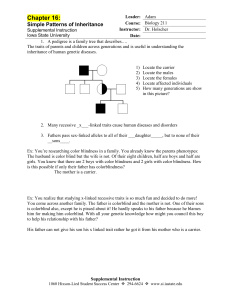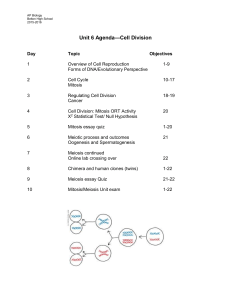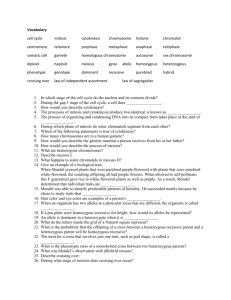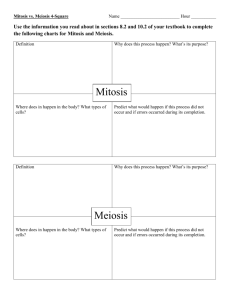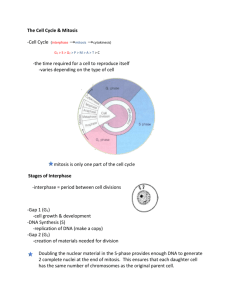Practice Exam
advertisement
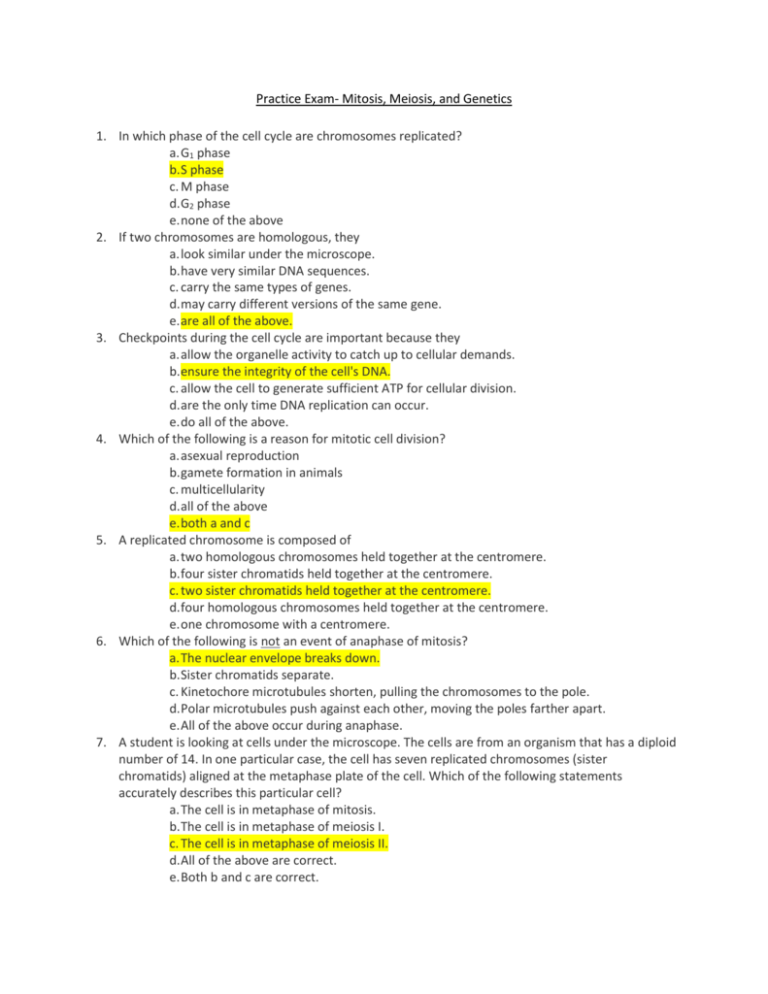
Practice Exam- Mitosis, Meiosis, and Genetics 1. In which phase of the cell cycle are chromosomes replicated? a. G1 phase b. S phase c. M phase d. G2 phase e. none of the above 2. If two chromosomes are homologous, they a. look similar under the microscope. b. have very similar DNA sequences. c. carry the same types of genes. d. may carry different versions of the same gene. e. are all of the above. 3. Checkpoints during the cell cycle are important because they a. allow the organelle activity to catch up to cellular demands. b. ensure the integrity of the cell's DNA. c. allow the cell to generate sufficient ATP for cellular division. d. are the only time DNA replication can occur. e. do all of the above. 4. Which of the following is a reason for mitotic cell division? a. asexual reproduction b. gamete formation in animals c. multicellularity d. all of the above e. both a and c 5. A replicated chromosome is composed of a. two homologous chromosomes held together at the centromere. b. four sister chromatids held together at the centromere. c. two sister chromatids held together at the centromere. d. four homologous chromosomes held together at the centromere. e. one chromosome with a centromere. 6. Which of the following is not an event of anaphase of mitosis? a. The nuclear envelope breaks down. b. Sister chromatids separate. c. Kinetochore microtubules shorten, pulling the chromosomes to the pole. d. Polar microtubules push against each other, moving the poles farther apart. e. All of the above occur during anaphase. 7. A student is looking at cells under the microscope. The cells are from an organism that has a diploid number of 14. In one particular case, the cell has seven replicated chromosomes (sister chromatids) aligned at the metaphase plate of the cell. Which of the following statements accurately describes this particular cell? a. The cell is in metaphase of mitosis. b. The cell is in metaphase of meiosis I. c. The cell is in metaphase of meiosis II. d. All of the above are correct. e. Both b and c are correct. 8. Which of the following statements accurately describes a difference between mitosis and meiosis? a. Mitosis may produce diploid cells, whereas meiosis produces haploid cells. b. Homologous chromosomes synapse during meiosis but do not synapse during mitosis. c. Crossing over commonly occurs during meiosis, but it does not commonly occur during mitosis. d. All of the above are correct. e. Both a and c are correct. 9. During crossing over in meiosis I, a. homologous chromosomes are not altered. b. homologous chromosomes exchange genetic material. c. chromosomal damage occurs. d. genetic information is lost. e. cytokinesis occurs. 10. Based on Mendel's experimental crosses, what is the expected F2 phenotypic ratio of a monohybrid cross? a. 1:2:1 b. 2:1 c. 3:1 d. 9:3:3:1 e. 4:1 11. During which phase of cellular division does Mendel's law of segregation physically occur? a. mitosis b. meiosis I c. meiosis II d. all of the above e. b and c only 12. An individual that has two different alleles of a particular gene is said to be a. dihybrid. b. recessive. c. homozygous. d. heterozygous. e. hemizygous. 13. Which of Mendel's laws cannot be observed in a monohybrid cross? a. segregation b. dominance/recessiveness c. independent assortment d. codominance e. All of the above can be observed in a monohybrid cross. 14. During a ___________ cross, an individual with the dominant phenotype and unknown genotype is crossed with a ___________ individual to determine the unknown genotype. a. monohybrid, homozygous recessive b. dihybrid, heterozygous c. test, homozygous dominant d. monohybrid, homozygous dominant e. test, homozygous recessive 15. A gene that affects more than one phenotypic trait is said to be a. dominant. b. wild type. c. dihybrid. d. pleiotropic. e. heterozygous 16. A hypothetical flowering plant species produces red, pink, and white flowers. To determine the inheritance pattern, the following crosses were conducted with the results indicated: red × red → all red white × white → all white red × white → all pink What type of inheritance pattern does this represent? a. dominance/recessiveness b. X-linked c. codominance d. incomplete dominance e. pleiotropy 17. Genes located on a sex chromosome are said to be a. X-linked. b. dominant. c. hemizygous. d. sex linked. e. sex influenced. 18. Tay-Sachs disease results when someone is homozygous recessive for the autosomal trait (tt). If two parents who did not have Tay-Sachs gave birth to a baby with Tay-Sachs, what are their genotypes? a. Tt x Tt b. TT x TT c. TT x Tt d. tt x tt 19. In humans, the ability to roll the tongue is a dominant trait. The inability to roll the tongue is a recessive trait. If two individuals homozygous recessive for this trait have a child, what is the chance that the child will be able to roll his tongue? a. 0% b. 100% c. 25% d. 75% e. 50% 20. What type of blood will the offspring of these parents have? Mother: AB Father: O a. AB b. A or B c. O d. Any one of the above 21. The AB blood type is an example of _________. a. Blending b. Incomplete dominance c. Complete dominance d. Codominance



